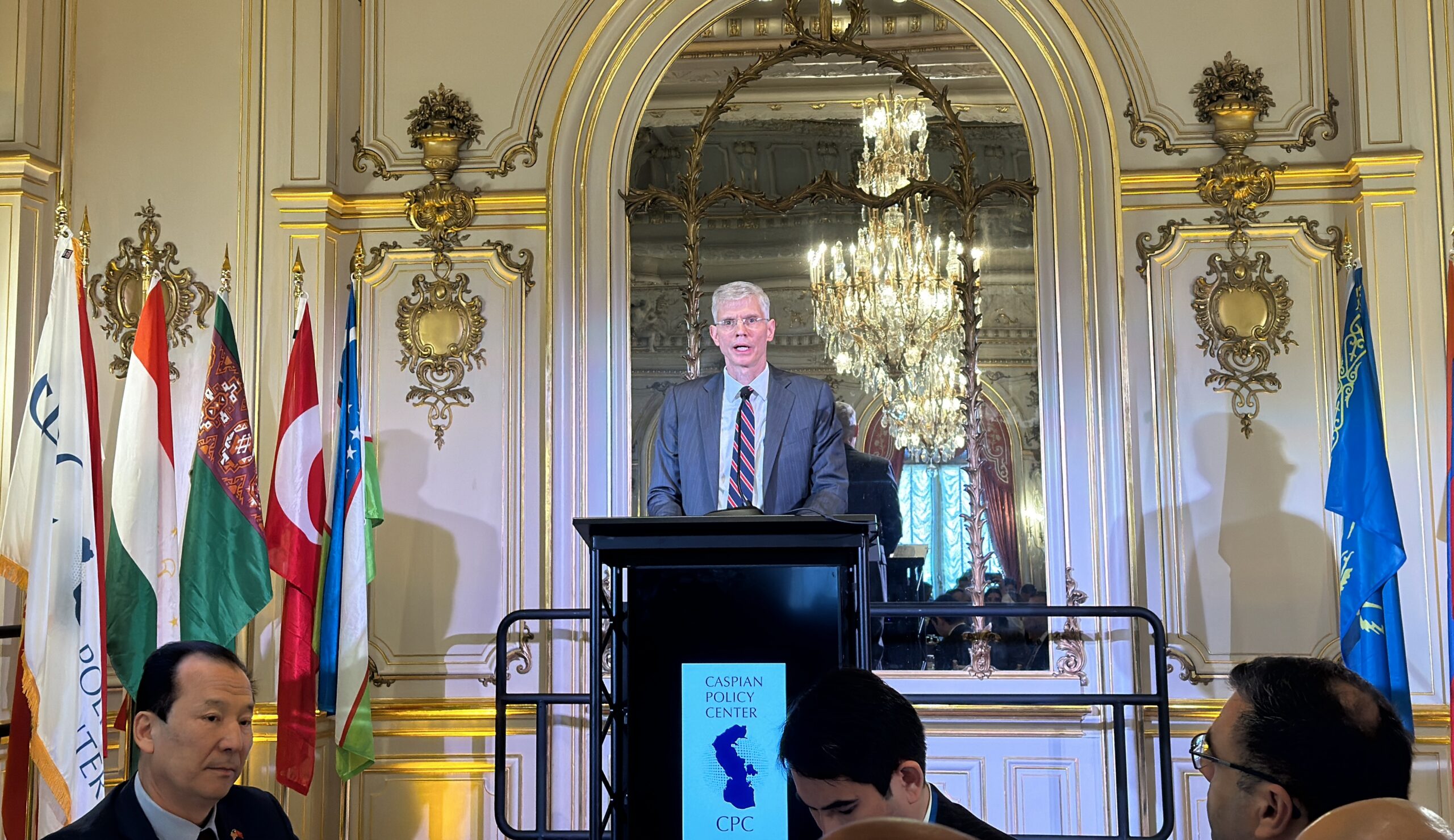A man was killed and a 5-year-old injured in a shooting at a youth football game at Potomac High School on Saturday morning.
Washington
Washington D.C. Hosts Annual Trans-Caspian Forum, Outlines Challenges – The Astana Times

ASTANA – The Caspian Policy Center organized the eighth Annual Trans-Caspian Forum on May 21 in Washington, D.C., to discuss the current challenges and prospects for a multi-modal Trans-Caspian International Transport Route (TITR) to maximize its capacity.
From L to R: Tamar Satterwhite from the Commercial Law Development Program; Winnie Wang from the World Bank; moderator Dr. Marsha McGraw Olive; Ambassador Erin McKee, Assistant Administrator for the Europe and Eurasia Bureau at the United States Agency for International Development (USAID); and Henrik Hololei from the European Commission. Photo credit: caspianpolicy.org
TITR is a multi-modal route that runs through China, Kazakhstan, the Caspian Sea, Azerbaijan, Georgia and further to European countries. The development of the route has been garnering growing attention, becoming increasingly vital to strengthen the region’s economic resilience and promote trade diversification.
According to data from the TITR International Association, the transportation volume along this corridor reached nearly 2.8 million tons in 2023, up from 1.7 million in 2022. In the first quarter of 2024, the figure hit 771 million tons.

Efgan Nifti addresses the forum. Photo credit: caspianpolicy.org
Addressing the opening session, Caspian Policy Center President Efgan Nifti noted “remarkable” developments in the Caspian region in the last 12 months. These include progress in developing the Middle Corridor, reconciliation steps between Armenia and Azerbaijan, increased engagement and investment from international partners, energy transition, and the increasing significance of critical minerals.
“The need for diversification of trade routes is obvious. This has injected new momentum into the development of regional transport connectivity in Central Asia and the South Caucasus. Further support of projects such as the Middle Corridor will not only boost political and economic relations within the region but also will support regional goals for connectivity, energy diversification, and long-term development,” said Nifti.
Kazakhstan’s vision
The development of the TITR also aligns with Kazakhstan’s goal to become a transport and logistics hub.
Deputy Chief of Mission at the Kazakh Embassy in the United States Rauan Tleulin stressed the importance of the route, also known as the Middle Corridor. According to him, TITR is a strategic corridor for supplying energy resources from the region to Europe and global markets.

Rauan Tleulin from the Kazakh Embassy in the United States. Photo credit: caspianpolicy.org
“Along with oil and gas, we are focused on the transportation of common goods and critical commodities,” said Tleulin.
He spoke about Kazakhstan’s efforts to develop TITR. “Together with Azerbaijan, Georgia, and Türkiye, we also adopted a roadmap for further eliminating the so-called bottlenecks. Implementation of the agreements will allow increasing overall trade capacity to 10 million tons per year by 2025,” said the diplomat.
The roadmap, signed in November 2022, outlines the priority directions for investments and actions needed to improve the TITR. In June 2023, Azerbaijan, Georgia, and Kazakhstan agreed to create a single logistics operator.
In 2023, Kazakhstan first shipped oil via TITR, pumping it into the Baku-Tbilisi-Ceyhan pipeline under the agreement between KazMunayGas and Azerbaijan’s SOCAR oil and gas company.
Improving connectivity
Arun Venkataraman, Assistant Secretary of Commerce for Global Markets and Director General of the U.S. and Foreign Commercial Service Global Markets for the U.S. Department of Commerce, urged the gathering to focus on upgrading transport and logistical connectivity.

Arun Venkataraman. Photo credit: caspianpolicy.org
He said it goes beyond “just seaports, airports, cargo from roads and rail lines and highways, but also communications infrastructure, safety and security systems.”
“At the Department of Commerce’s International Trade Administration, it is our job to help businesses find partners overseas, meet their goals, and find solutions to help them advance those goals,” said Venkataraman.
Increased U.S. engagement benefits TITR development
The development of the corridor also benefits from increased engagement between the United States and the region, mainly Central Asia. Deputy Assistant Secretary of State for Central Asia John Mark Pommersheim said U.S. engagement with Central Asian leaders is now higher than ever.

Ambassador John Mark Pommersheim. Photo credit: caspianpolicy.org
“Our cooperation has reached a new high over the past year,” he said, stressing the importance of the declaration signed by all five Central Asian leaders and the U.S. President in September 2023.
“We have an opportunity for the U.S. government to leverage enhanced coordination among our international partners, including for the G7 and other like-minded partners working in Central Asia, to share this common goal of advancing regional connectivity and economic resilience in Central Asia and the South Caucasus,” said the American diplomat.
Outlook from beyond
Addressing the second panel of the forum, Hors Classe Adviser to the Directorate-General for International Partnerships at the European Commission Henrik Hololei said the development of TITR into a “modern, multimodal economic gateway” is one of the key projects for the European Union.
“It is in all our interests to make the corridor competitive, predictable, affordable, and sustainable,” he said.
Hololei emphasized that developing this corridor is more crucial now than ever before.
“It’s now or never for the corridor,” he said. “During the Soviet era, the corridor was purposefully not integrated. This was a policy of division, not integration. Now, however, we have an opportunity to put it right.”
In doing so, he announced that Astana would host the launch of the EU-Central Asia coordination platform in a few weeks. The platform will establish a permanent framework aimed at fostering the implementation of projects in Central Asia.
In a recent interview with The Astana Times, Hololei expressed high hopes about the route, saying it could become a game changer in Asia-Europe connectivity.
Tamar Satterwhite, senior counsel for the Commercial Law Development Program (CLDP) at the Office of the General Counsel at the U.S. Department of Commerce, drew attention to the poor coordination among countries along the corridor and investors.
“There is a lack of coordination among the donor organizations, among the countries, and specific ministries in each country. This includes lack of information sharing,” said Satterwhite.
Costs to address the bottlenecks
In its 2023 study, the European Bank for Reconstruction and Development estimated the cost of addressing hard and soft infrastructure needs of the corridor could reach 17 billion euros (US$18.4 billion).
Winnie Wang, a lead infrastructure specialist and program leader for Europe and Central Asia at the World Bank, disclosed the World Bank’s estimates. She said the cost of priority investments may reach around $7 billion.
“We see great impacts when projects are designed to address specific bottlenecks and to define the level of service. To this end, at the World Bank, we have employed a number of regional and global monitoring tools to give the corridor solutions,” said Winnie Wang.
In November 2023, the group released a study called Unlocking the Potential of the Middle Corridor, focusing on Kazakhstan, Azerbaijan, and Georgia. The study suggests measures that can transform TITR into a vital trade route.
Among the recommendations are implementing corridor-length logistics solutions for seamless operations, simplifying border crossing procedures to facilitate traffic and data exchanges, improving digital solutions and establishing a uniform system for prioritizing investments.
According to the study, with the right policies and investments, the corridor can triple trade volumes by 2030 to 11 million tons compared to 2021 levels and reduce travel time by half.

Washington
Raptors Reportedly Worked out Former Top Prospect Out of Washington

It wasn’t all that long ago that Keion Brooks Jr. was tabbed to be the next star forward from Kentucky.
At the time, Brooks was a five-star prospect set to join a Wildcats class headlined by future NBA All-Star Tyrese Maxey in the collegiate class of 2019. The expectation was Brooks would have a brief tenure at Kentucky before a long and successful NBA career.
But Brooks’ journey didn’t quite work out as expected.
After three seasons at Kentucky, the 6-foot-8.5 wing transferred to Washington where he’s spent the past two years trying to prove to NBA scouts that he’s still the prospect people once thought he was. It wasn’t quite enough to land him a spot at the NBA draft combine, but the former No. 14 high school recruit in the country has reportedly landed a workout with the Toronto Raptors, according to The Rookie Wire.
The 23-year-old Brooks had a breakout season with the Huskies this past year, averaging 21.1 points and 6.8 rebounds per game while shooting 38% from behind the arc. It was a monumental jump for Brooks who’d been a 26.5% three-point shooter through the first four years of his collegiate career.
If the growth in Brooks’ three-point shooting is real, so is he as a prospect. He’s long and athletic with the physical tools to be a good wing defender and if he can space the floor he’ll have the potential to be a 3-and-D forward at the next level.
The rest of Brooks’ game still needs development though. He’s not a very good playmaker with a negative assist-to-turnover ratio and he lacks the explosiveness to be an impact shot creator. Defensively his size should allow him to be a versatile defender, but he’ll need some time in the G League to make the most of his potential.
It’s unlikely Brooks’ hears his name called when the NBA draft rolls around later this month, but players with his pedigree and size don’t normally last long after the draft. Considering Toronto’s need for more wing depth, it wouldn’t be hard to see the Raptors going after Brooks with a two-way deal for next season.
Washington
Man dead, child injured at Prince George’s football game shooting

Both were transported to the hospital where the man was pronounced dead. The 5-year-old is receiving treatment for non-life-threatening injuries.
Aziz said that the two people in the altercation knew each other and the dispute was over something that had happened outside the game. “And [they] brought it to a game where young people, 7-year-olds, were playing a football game, out enjoying this beautiful day with their families,” Aziz said.
He said the homicide unit is investigating the shooting.
“The work we have to do in this moment is not just reactive,” County Executive Angela D. Alsobrooks (D) said at the news conference. “We really have to continue as a community, and we have to do so in partnership with neighboring jurisdictions, to make sure we are doing everything in our power to remove guns from our communities.”
Washington
Deputy fatally shoots seven starving, abandoned dogs

The Apache County Sheriff’s Office, which serves roughly 65,000 people, maintains that the deputy did nothing wrong that day in September. Chief Deputy Roscoe Herrera said that since the county has no animal control service, deputies have discretion to handle animal issues as they see fit. The deputy, Jarrod Toadecheenie, declined to comment.
But the incident in Adamana, Ariz. — an unincorporated community about 100 miles east of Flagstaff — has outraged local animal advocates who say that shooting the dogs was the wrong solution and that the area desperately needs to address animal hoarding and abandonment. Some residents have launched Facebook groups to try to find homes for abandoned dogs and to expose people who illegally hoard animals.
“The Apache County Sheriff’s Office won’t do anything to fix the problem,” said Teresa Schumann, founder of the nonprofit Northern Arizona Animal Search and Rescue. “Animals are dying everywhere in the county.”
Molly Ottman, executive editor of the Mountain Daily Star, first obtained the body-camera footage of the incident and shared it with The Washington Post.
The dogs who were shot were owned by a divorcing couple who had abandoned the property, Toadecheenie wrote in the incident report. He wrote that he visited the home several times over a span of three weeks after neighbors called to complain about the canines.
On the first visit, he counted 10 dogs, “all of which seemed to be in good health.” A few days later, the deputy wrote, he responded to a call that the dogs had chased a neighbor’s donkey.
Toadecheenie contacted Schumann, who said she was struggling to find new owners for the dogs when the deputy called and said he would “handle it.” Schumann said she told him the dogs may need to be euthanized if they were feral.
On Sept. 22, Schumann told Toadecheenie that she hadn’t been able to find new homes for the dogs. After telling his supervisor that he planned to shoot the dogs, the deputy bought dog food and a tray, and collected water from a fire station.
Then he went to the couple’s property, corralled the dogs with the food and water, put on headphones and began to shoot the canines, the body-camera footage shows. Toadecheenie shot one dog two additional times as it continued to move.
Two dogs ran away uninjured and hid under a shed. They were later brought to a local animal shelter by Schumann. One died of parvovirus shortly after arriving, and the other was adopted, said Brandon Smigiel, a supervisor at Holbrook Animal Care and Control.
In the incident report, Toadecheenie recommended that the couple who allegedly abandoned the dogs be charged with animal cruelty. No charges had been filed as of Friday, according to county records.
Herrera, the sheriff’s chief deputy, acknowledged that the situation had caused the community “distress.”
“This tragic decision was made under extremely difficult circumstances due to a combination of limited resources, the willful neglect and abandonment of the dogs by their original owners, and the considerable amount of time spent seeking assistance from outside resources,” he said in a statement to The Post.
In a separate statement provided to KPNX 12 News on June 6, the sheriff’s office seemed to blame a lack of funding.
“Apache County does not have an animal care and control department. In the unincorporated areas that responsibility is left up to the deputies and actions taken vary and are considered on a case-by-case basis. We do not have the infrastructure or budget to support such a department.”
Schumann, who runs the rescue nonprofit, said she never thought the deputy would shoot the animals.
“It infuriates me when the sheriff’s office says they don’t have the resources” to handle animal situations differently, she said. “There are plenty of people who are trying to help.”
The Arizona Humane Society called the situation “entirely preventable” and lamented that the sheriff’s office had not asked it for help.
“This awful incident lacked all compassion and judgement,” Jennifer Armbruster, a spokeswoman for the humane society, said in a statement. “And what is most clear is that establishing an animal care and control service in Apache County is an absolute necessity to prevent something like this from happening in the future.”
Animal hoarding is at “epidemic levels” in Arizona, creating dangerous situations, said Terri Hoffman, founder of Animal Rights Champions of Arizona. Last summer, three mixed-breed pit bulls mauled a 2-year-old Apache County girl to death. Still, Hoffman said that she wants the deputy to be held accountable and that killing abandoned dogs is not an appropriate solution to hoarding.
“I’ve been to homes where there’s over 53 dogs,” Hoffman said. “Some people hoard horses and goats out here, too. I’ve seen dogs with open wounds, severe infections. Animals are dying.”
-

 News1 week ago
News1 week agoIsrael used a U.S.-made bomb in a deadly U.N. school strike in Gaza
-

 World1 week ago
World1 week agoFrance to provide Ukraine with its Mirage combat aircraft
-

 World1 week ago
World1 week agoWorld leaders, veterans mark D-Day’s 80th anniversary in France
-

 World1 week ago
World1 week agoRussia-Ukraine war: List of key events, day 833
-

 Movie Reviews1 week ago
Movie Reviews1 week agoInsane Like Me? – Review | Vampire Horror Movie | Heaven of Horror
-

 News1 week ago
News1 week agoNonprofit CFO Accused of 'Simply Astonishing' Fraud
-

 Politics1 week ago
Politics1 week agoGeorge Clooney called White House to complain about Biden’s criticism of ICC and defend wife’s work: report
-

 Politics1 week ago
Politics1 week agoNewson, Dem leaders try to negotiate Prop 47 reform off California ballots, as GOP wants to let voters decide















